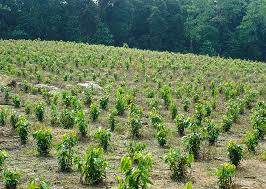Cinnamon farming
Cinnamon farming involves the cultivation and harvesting of cinnamon trees for the production of cinnamon spice. Cinnamon is a popular and valuable spice known for its aromatic flavor and various culinary uses. Here's some information about cinnamon farming:
Cinnamon Tree: Cinnamon comes from the inner bark of trees belonging to the Cinnamomum genus. The most common types of cinnamon are Cinnamomum verum (Ceylon cinnamon) and Cinnamomum cassia (Chinese cinnamon).
Climate and Soil: Cinnamon trees thrive in tropical or subtropical climates with a temperature range of 20-30°C (68-86°F) and high humidity. They require well-drained, fertile soil rich in organic matter.
Propagation: Cinnamon trees are propagated through seeds or vegetative methods like stem cuttings and layering. Seed propagation is less common due to a longer time to maturity, so most farmers prefer vegetative propagation for faster and more reliable results.
Plantation Establishment: Cinnamon trees are usually grown in nurseries for a few months before transplanting them to the field. They need partial shade during the early stages of growth.
Plantation Management: Proper care is essential to ensure healthy growth and maximum yield. This includes regular watering, fertilization, and weed control. Pruning is also necessary to maintain tree shape and encourage lateral branching.
Harvesting: Cinnamon trees are typically harvested when they are around 2-3 years old. The bark is carefully removed from the main stems and branches. The outer bark is scraped off, revealing the inner bark, which is then left to dry.
Processing: Once harvested, the cinnamon bark is sun-dried or machine-dried until it curls into quills. These quills are then cut into smaller pieces or ground into powder, depending on the intended use.
Marketing: Cinnamon is in high demand worldwide, both as a spice and for various other applications like perfumes and essential oils. Farmers can sell their cinnamon to spice traders, wholesalers, or directly to consumers through local markets or online platforms.
Challenges: Cinnamon farming faces challenges such as disease and pest management, as cinnamon trees can be susceptible to fungal infections and insects. Proper pest control and disease prevention measures, including regular monitoring and the use of organic or chemical treatments when necessary, are important.
Sustainability: Sustainable farming practices, such as organic cultivation and responsible land management, can help preserve soil fertility, minimize environmental impact, and ensure the long-term viability of cinnamon farming.
It's worth noting that the specific practices and techniques may vary depending on the region and the type of cinnamon being cultivated. Local agricultural extension services or cinnamon farming associations can provide more region-specific guidance for those interested in cinnamon farming
Follow me more details
Click on the link 🔗🖇️👇










Comments
Post a Comment